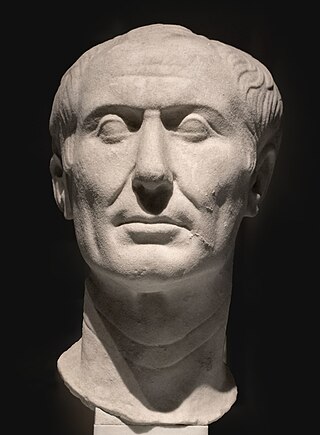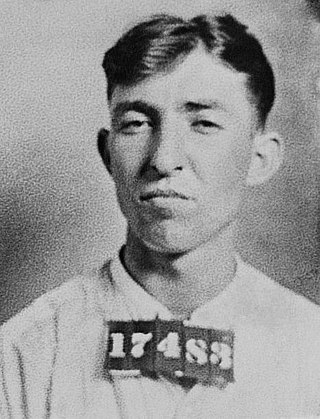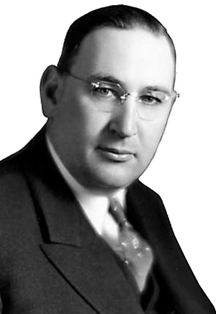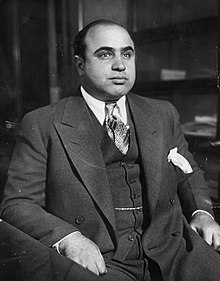
John Herbert Dillinger was an American gangster during the Great Depression. He commanded the Dillinger Gang, which was accused of robbing 24 banks and four police stations. Dillinger was imprisoned several times and escaped twice. He was charged with but not convicted of the murder of an East Chicago, Indiana, police officer, who shot Dillinger in his bullet-proof vest during a shootout; it was the only time Dillinger was charged with homicide.

Lester Joseph Gillis, also known as George Nelson and Baby Face Nelson, was an American bank robber who became a criminal partner of John Dillinger, when he helped Dillinger escape from prison, in Crown Point, Indiana. Later, the Federal Bureau of Investigation (FBI) announced that Nelson and the remaining gang of bank robbers were collectively "Public Enemy Number One".

The terms enemy of the people and enemy of the nation are designations for the political opponents and for the social-class opponents of the power group within a larger social unit, who, thus identified, can be subjected to political repression. In political praxis, the term enemy of the people implies that political opposition to the ruling power group renders the people in opposition into enemies acting against the interests of the greater social unit, e.g. the political party, society, the nation, etc.

Kate Barker, better known as Ma Barker, was the mother of several American criminals who ran the Barker–Karpis Gang during the "public enemy era" when the exploits of gangs of criminals in the Midwestern United States gripped the American people and press. She traveled with her sons during their criminal careers.

Alvin Francis Karpis, was a Canadian–American criminal of Lithuanian descent known for being a leader of the Barker–Karpis gang in the 1930s. Nicknamed "Creepy" for his sinister smile and called "Ray" by his gang members, Karpis led the gang along with Fred Barker and Arthur "Doc" Barker. There were only four "public enemies" ever given the title of "Public Enemy #1" by the FBI and he was the only one to be taken alive. The other three, John Dillinger, Pretty Boy Floyd, and Baby Face Nelson, were all killed before being captured. He also spent the longest time as a federal prisoner at Alcatraz Federal Penitentiary, serving twenty-six years.

Dillinger is a 1973 American biographical gangster film, dramatizing the life and criminal exploits of notorious bank robber John Dillinger. It is written and directed by John Milius in his feature directorial debut, and stars Warren Oates as Dillinger, Ben Johnson as FBI Agent Melvin Purvis, and Michelle Phillips in her first film performance as Dillinger's moll Billie Frechette. Other actors in the film include Cloris Leachman, Harry Dean Stanton, and Richard Dreyfuss.

Guns Don't Argue is a 1957 low-budget feature film about the early achievements of the FBI in defeating the most notorious criminals of the 1930s. The film involves dramatizations of the crimes and eventual demise of various gangsters, along with a moralistic narrative. It was edited together from a composite of three episodes from the 1952 TV series Gangbusters.

Public Enemies is a 2009 American biographical crime drama film directed by Michael Mann, who co-wrote the screenplay with Ronan Bennett and Ann Biderman. It is an adaptation of Bryan Burrough's 2004 non-fiction book Public Enemies: America's Greatest Crime Wave and the Birth of the FBI, 1933–34. Set during the Great Depression, the film chronicles the final years of the notorious bank robber John Dillinger as he is pursued by FBI agent Melvin Purvis, Dillinger's relationship with Billie Frechette, as well as Purvis' pursuit of Dillinger's associates and fellow criminals John "Red" Hamilton, Homer Van Meter, Harry Pierpont, and Baby Face Nelson.
Frank Joseph Loesch was a prominent Chicago attorney, reformer and a founder of the Chicago Crime Commission, which attempted to combat widespread corruption and organized crime related violence.

Joseph P. Moran (1895–1934) was an American medical doctor known for catering to the Depression-era criminal underworld in the early 20th century. He was also a peripheral member of the Barker-Karpis gang, and was possibly the last physician to see the mortally wounded John Hamilton, a member of the John Dillinger gang, whom Moran refused to treat.
Fred Samuel Goetz, also known as "Shotgun" George Ziegler, was a Chicago Outfit mobster and a suspected participant in the Saint Valentine's Day Massacre, in 1929.

Arthur Raymond "Doc" Barker was an American criminal, the son of Ma Barker and a member of the Barker-Karpis gang, founded by his brother Fred Barker and Alvin Karpis. Barker was typically called on for violent action, while Fred and Karpis planned the gang's crimes. He was arrested and convicted of kidnapping in 1935. Sent to Alcatraz Federal Penitentiary in 1936, he was killed three years later while attempting to escape.
Public Enemy No. 1, or variants, may refer to:
Mafia films—a version of gangster films—are a subgenre of crime films dealing with organized crime, often specifically with Mafia organizations. Especially in early mob films, there is considerable overlap with film noir. Popular regional variations of the genre include Italian Poliziotteschi, Chinese Triad films, Japanese Yakuza films, and Indian Mumbai underworld films.

Volney Everett "Curley" Davis was an American bank robber and Great Depression-era outlaw. A longtime Oklahoma bandit, he was the boyfriend of Edna Murray and an associate of both the John Dillinger and Alvin Karpis-Barker gangs during the 1930s.

Harold Eugene "Eddie" Green was an American bank robber and Depression-era outlaw during the 1930s, best known as a member of the John Dillinger gang. He was also associated with Frank "Jelly" Nash, Volney Davis and the Barker-Karpis Gang in his early career.

Frederick George Barker was an American criminal who, along with Alvin Karpis, co-founded the Barker-Karpis gang, which committed numerous robberies, murders and kidnappings during the 1930s. Barker was the youngest son of Ma Barker, all of whose children were criminals. He was killed in a lengthy gunfight with the Federal Bureau of Investigation (FBI) in 1935.

The era of American film production from the early sound era to the enforcement of the Hays Code in 1934 is denoted as Pre-Code Hollywood. The era contained violence and crime in pictures which would not be seen again until decades later. Although the Hays office had specifically recommended removing profanity, the drug trade, and prostitution from pictures, it had never officially recommended against depictions of violence in any form in the 1920s. State censor boards, however, created their own guidelines, and New York in particular developed a list of violent material which had to be removed for a picture to be shown in the state. Two main types of crime films were released during the period: the gangster picture and the prison film.

Herman Edward "Ed" Hollis was an American Federal Bureau of Investigation (FBI) special agent. As an FBI special agent in the 1930s, Hollis worked with agents Melvin Purvis, Samuel P. Cowley and others fighting bank robbers, gangsters and organized crime in the Chicago area during the Great Depression. Hollis is best known for having been killed in the line of duty during an intense shootout with Chicago-area bank robber Lester Gillis, a.k.a. Baby Face Nelson, at the Battle of Barrington in 1934. Hollis was also one of the three FBI special agents who shot John Dillinger near the Biograph Theater earlier that year, resulting in Dillinger's death. One controversial account also implicates Hollis in the death of Pretty Boy Floyd. Hollis served as a special agent for the FBI's field offices in Kansas City, Cincinnati, and Chicago for over seven years; at the time of his death, he was 31 years old.

Thomas Archibald Brown, also known as Big Tom, was an American law enforcement official who served as chief of the Saint Paul Police Department (SPPD) during the Great Depression and became notorious for flagrant police corruption.






















